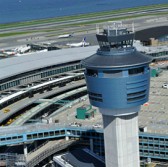 NASA and Uber Technologies have teamed up to identify new urban air mobility-related technologies and concepts designed to ensure safety of aerial transportation operations in populated areas.
NASA and Uber Technologies have teamed up to identify new urban air mobility-related technologies and concepts designed to ensure safety of aerial transportation operations in populated areas.
The agency said Wednesday Uber will share its implementation plans for an urban aviation rideshare network, while NASA will use computer modeling and simulation for airspace management to evaluate the potential impact of drones and other small aircraft when used in dense environments under a new space act agreement.
NASA and Uber will determine safety issues by simulating a small passenger plane as it flies through the airspace of the Dallas Fort Worth International Airport in Texas during peak air travel times.
Uber also signed a new agreement with the U.S. Army Research Lab within the service’s Research, Development and Engineering Command to develop and test vehicles for the company’s proposed uberAIR rideshare network.
Uber and ARL plan to jointly allocate $1 million in total funds to support research-and-development work on rotor technology under a cooperative research and development agreement.
The company also teamed up with LaunchPoint Technologies to build co-rotating propellers designed to power electric vertical takeoff-and-landing vehicles.
Uber has partnered with aircraft manufacturers such as Boeing’s Aurora Flight Sciences subsidiary, Bell, Embraer and Pipistrel Aircraft to advance the development of eVTOL vehicles and collaborated with Sandstone Properties and Hillwood Properties to develop skyports for the planned uberAIR network.




